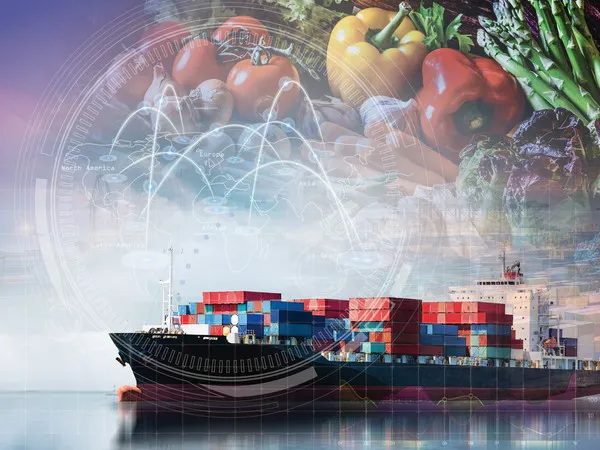 Two weeks ago, an article was published that included best practices for protecting perishable shipments throughout the international cold chain. In the best of circumstances, the task of shipping perishable product is fraught with challenges. “However, maintaining consistent holding temperatures and proper quality assurance (QA) processes can be even harder when shipments cross borders into foreign countries,” says Mayra Shaw with Emerson’s Cold Chain Digital Solutions division.
Two weeks ago, an article was published that included best practices for protecting perishable shipments throughout the international cold chain. In the best of circumstances, the task of shipping perishable product is fraught with challenges. “However, maintaining consistent holding temperatures and proper quality assurance (QA) processes can be even harder when shipments cross borders into foreign countries,” says Mayra Shaw with Emerson’s Cold Chain Digital Solutions division.
Unlike domestic perishable shipments transporting (or exporting) goods across borders introduces a variety of new considerations and potential quality hazards. Every country has specific border and customs procedures that are driven by their own unique food safety regulations — which oftentimes differ from the country of origin.
"Add to that the fact that international shipments utilize multiple modes of transportation and can last from days to weeks and even months. These extended cold chain journeys pass through higher-risk zones or unfamiliar regions that can make shipments more prone to delays, theft, tampering and associated complications."
The greatest potential risks include temperature excursions, rejected shipments and late deliveries and shipment tampering or theft. In the last article, the focus was on the best practices for preventing those risks by protecting perishable shipments by being cognizant of timeliness and security. This article will focus on how proper handling during cross-border transfers and understanding import regulations can help maintain the cold chain.

Best Practice: Expedite transfers and inspections
International shipments are more likely to experience changes of custody or transfers when they cross into new countries, which can increase the potential for temperature excursions. Typically, different carrier companies, 3PLs and/or drivers are designated to handle shipments in their native countries. Shipping changes of custody occur at border crossings generally in one of two ways: shipment trailer drop-offs; or a complete transfer of goods to another refrigerated trailer. Container and/or trailer doors may also be open during border inspections.
“It’s essential to maintain proper handling temperatures during transfers and inspections, and not allow perishables to experience temperature fluctuations,” said Shaw. Connected cold chain temperature tracking software enables real-time visibility to alert stakeholders during critical transfers by:
- Enabling geo-fences along border transfer points to alert stakeholders to monitor and manage transfer efficiencies.
- Monitoring temperatures to ensure product quality and safety.
- Gaining the intelligence and information to make changes to delivery destinations or diverting product to the nearest point of sale.
Best Practice: Understand and comply with import regulations
“In the international cold chain, many countries of origin where goods are produced simply don’t have the same strict food safety regulations or requirements that are enforced in many destination countries, such as the U.S. or the U.K.,” Shaw commented. Stakeholders should be prepared to understand and demonstrate proof of compliance before crossing a border, which often requires the ability to produce temperature logs that provide a clear record of refrigerated shipping container temperatures throughout the cold chain journey.
A combination of expertise and cold chain tracking software can alleviate the complexities of cross-border inspections and foreign country regulatory compliance. International cold chain companies have a network of dedicated experts ready to advise on complying with the regulatory requirements of various destination countries.
These experts can help stakeholders to develop standard operating procedures (SOPs) and QA programs geared toward maintaining compliance at various points (or ports) of entry. In addition to providing real-time notifications and alerts, cold chain tracking software can:
- Maintain historical records of shipments.
- Provide inspectors with a link to post-shipment temperature and location information.
- Contribute to a data warehouse from which cold chain insights, reports and scorecards can be generated.
Follow the data
By following these best practices, global stakeholders in the perishable cold chain can address a full range of cross-border challenges. The combination of data-driven software and cold chain expertise can give stakeholders the tools they need to maximize product quality, safety, and security. With the right software and deep cold chain domain expertise, stakeholders can:
- Maintain an automated record of shipment temperatures so 3PLs can provide border patrol with proof of proper cold chain management.
- Aggregate data points from stakeholders and throughout changes of custody into a unified view of real-time cold chain status.
- Receive real-time alerts to make decisions quickly and protect goods when needed.
- Uncover root causes of issues and provide objective score-carding.
"Knowing the regulatory requirements of different countries can help your company to develop QA processes that ensure compliance," Shaw said. "Implementing holistic cold chain quality and safety best practices is beneficial for all perishable stakeholders."
 For more information:
For more information:
Mayra Shaw
Emerson
Tel: (+1) 770-425-2724
Mayra.Shaw@Emerson.com
www.emerson.com
